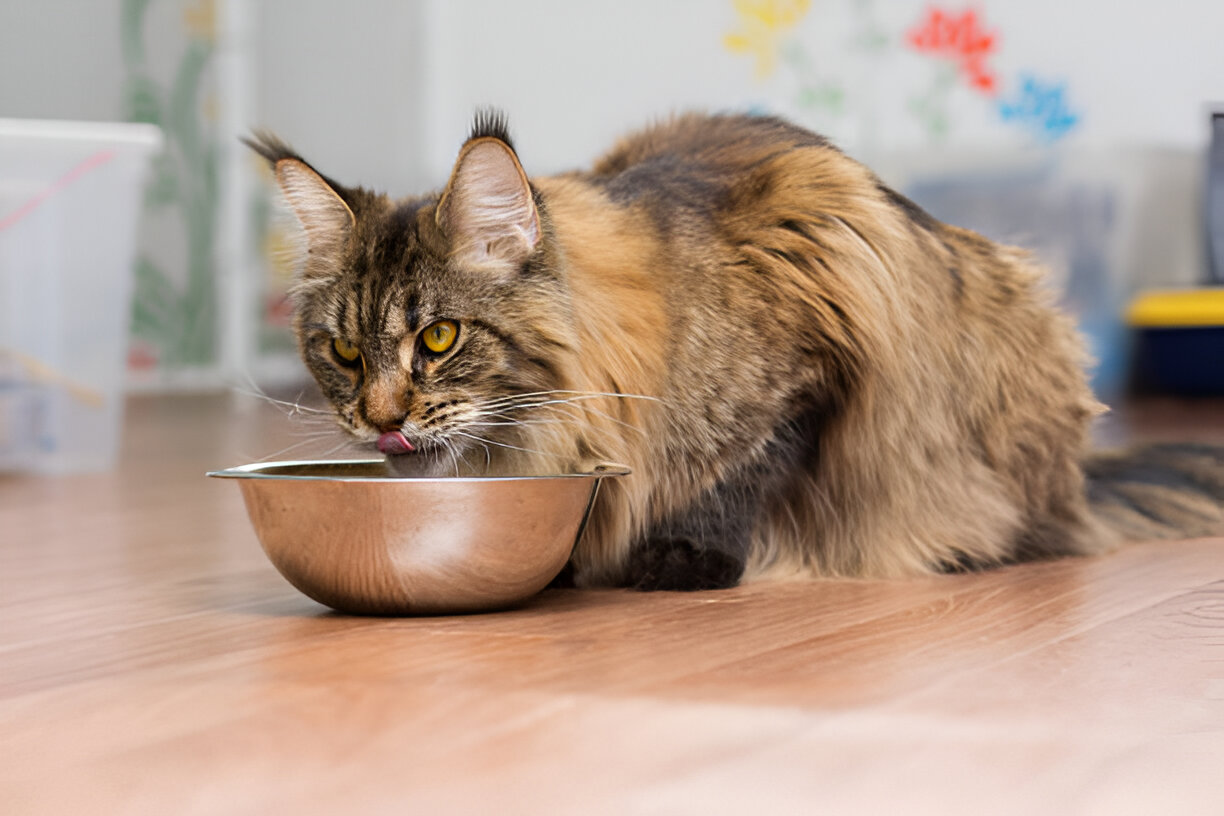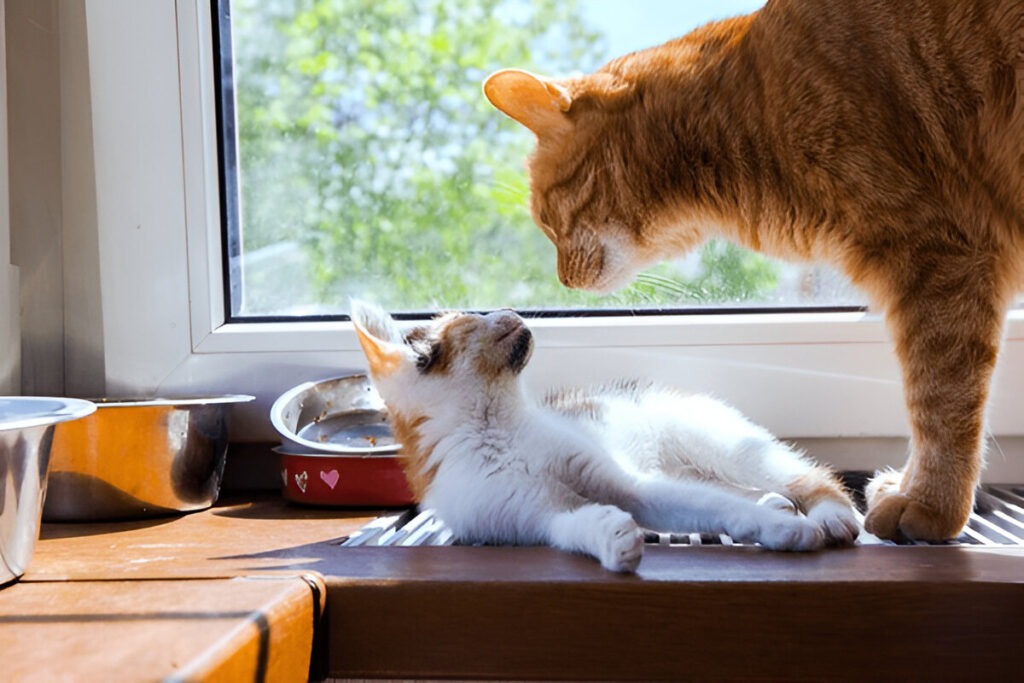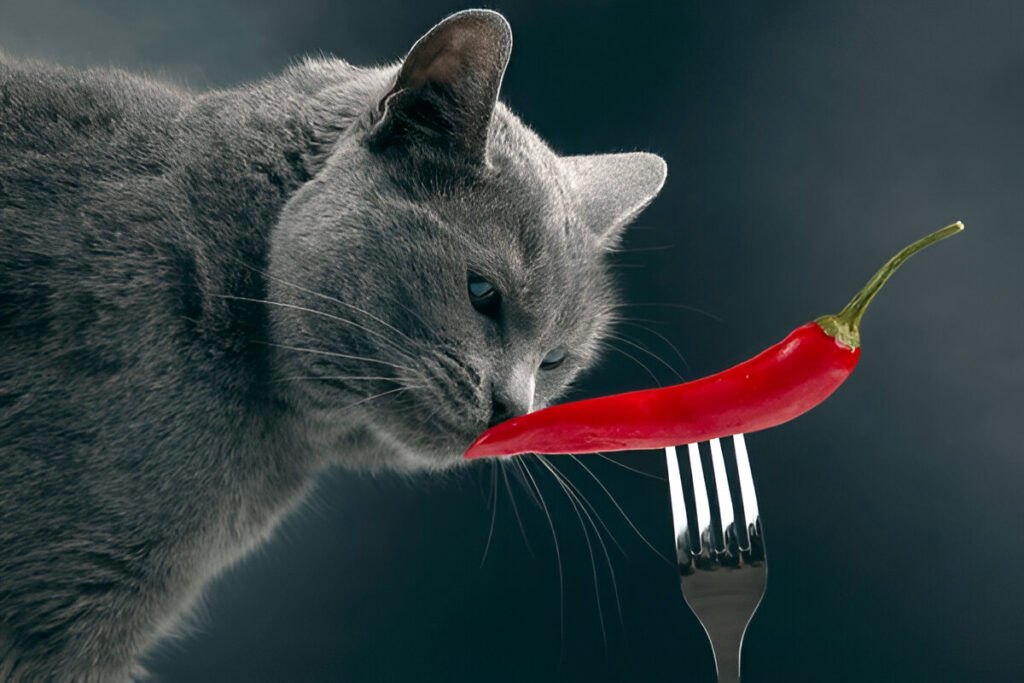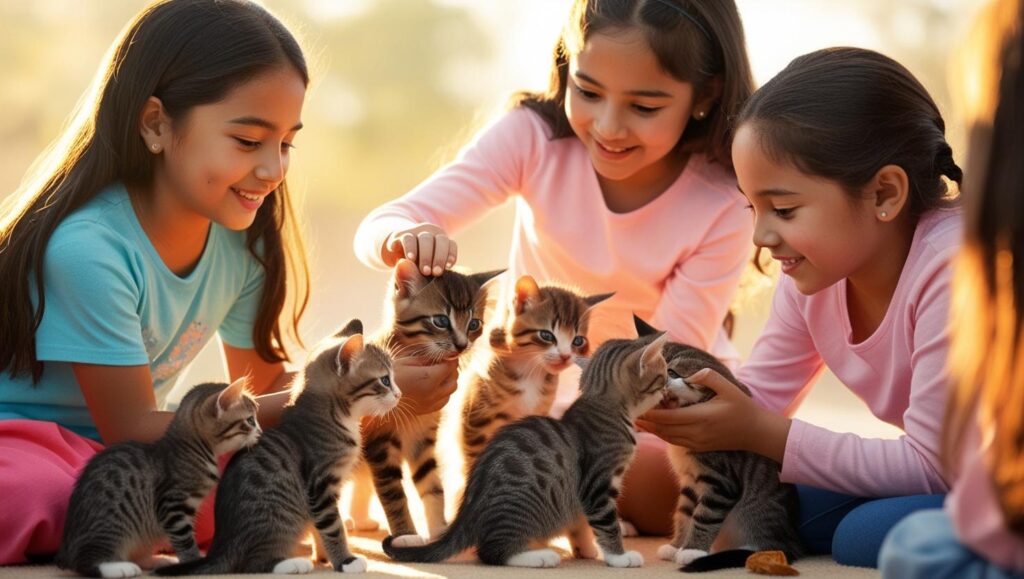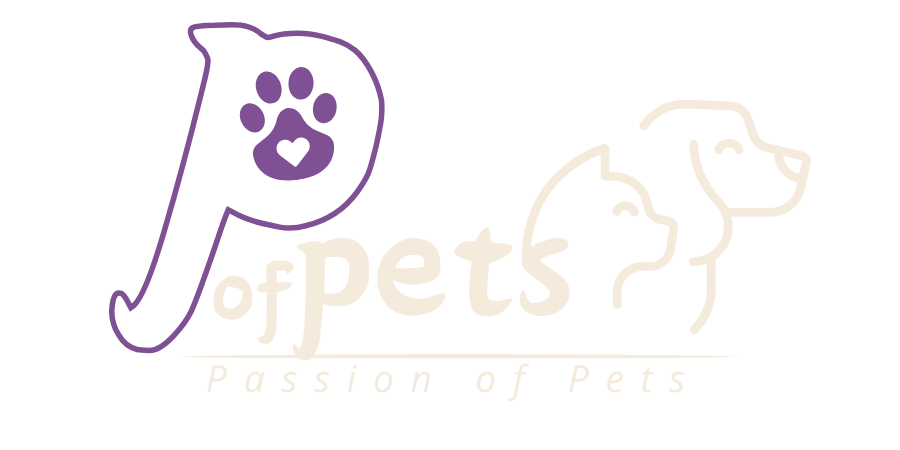How Much Should an Adult Cat Eat?
Cats are beloved companions, cherished for their playful antics, graceful movements, and independent nature. Ensuring they stay healthy and happy requires understanding their dietary needs. One of the most common questions among cat owners is: “How much should my adult cat eat?”
The answer depends on various factors, including age, weight, activity level, and overall health. In this blog, we’ll delve into the intricacies of feline nutrition, providing detailed insights to help you determine the right amount of food for your furry friend.
Understanding a Cat’s Nutritional Needs
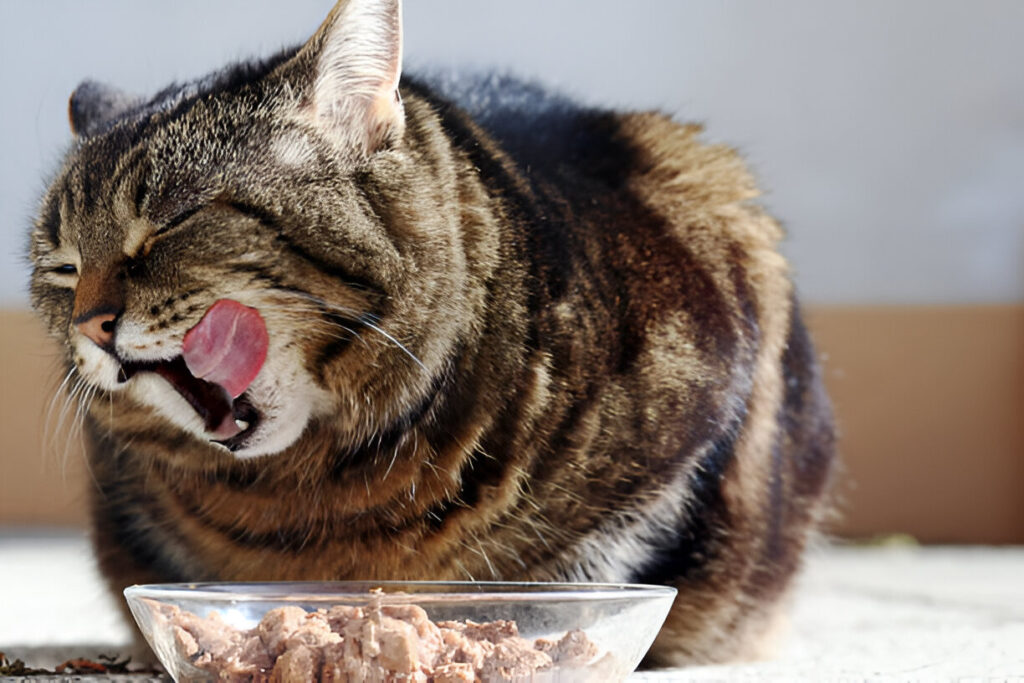
Being able to understand and provide for a cat’s nutritional requirements is integral to their health and lifespan. Cats, being obligate carnivores, have certain food needs that are quite different from other animals. Here’s a breakdown of some important ones:
Key Nutritional Components for Cats:
- Protein:
- Cats require high levels of animal-based protein to sustain muscle mass, repair tissues, and maintain overall health.
Unlike omnivores, their metabolism is so arranged as to derive essential amino acids, such as taurine, only from animal proteins.
- Taurine:
- Taurine is an essential amino acid that cats cannot synthesize in adequate amounts on their own.
- It supports heart function, retinal health, reproduction, and digestion.
- A deficiency in taurine leads to severe health issues such as dilated cardiomyopathy and even blindness.
- Fats:
- Fats are energy-dense and facilitate the absorption of fat-soluble vitamins, namely, A, D, E, and K.
- The fatty acids, especially omega-3 and omega-6, have a major role in skin health, giving the coat its shine, and are anti-inflammatory agents.
- Vitamins and Minerals:
- Vitamins A, B-complex, D, and E are required for vision, metabolic function, and overall vitality.
Minerals such as calcium, phosphorus, magnesium, and potassium are important for a number of bodily functions relating to bone structure, muscular contraction, and enzymatic activity.
Cats have a requirement for preformed vitamin A, which is derived only from animal tissues since the conversion of beta-carotene to vitamin A is ineffective in cats.
- Water:
- They have a relatively low thirst drive and are very well adapted to acquire much of their needed water from the food they consume.
A diet that consists of more wet food is usually good for preventing dehydration, urinary problems, and kidney diseases in cats.
Building a Well-Balanced Diet
- Commercial Cat Food: Feed high-quality, complete, and balanced cat foods that are formulated to meet the levels established by a recognized organization such as the Association of American Feed Control Officials (AAFCO).
- Home-Prepared Diets: When feeding homemade diets, consult with your veterinarian or a pet nutritionist to ensure that all the nutrients in the diet are adequate. Raw or undercooked foods should never be fed unless properly controlled to prevent bacterial infections.
- Harmful Foods to Avoid: Cats must never be given chocolate, onions, garlic, grapes, and too much of plant-based food items due to their toxicity.
Factors Influencing Food Intake
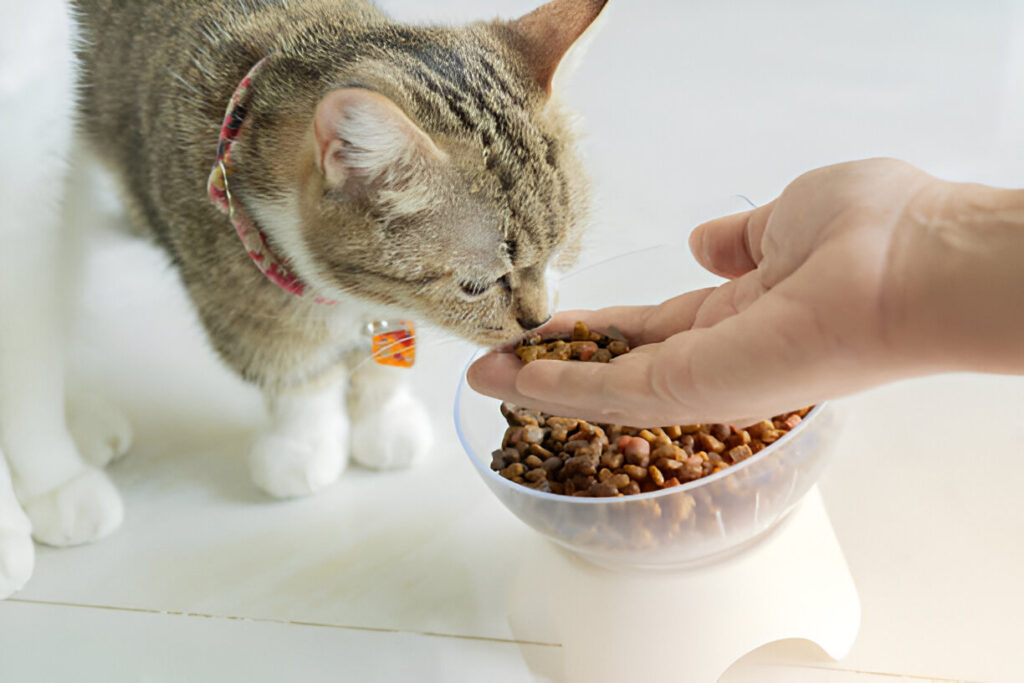
Knowing what affects your cat’s food consumption is important to ensure that they are receiving the right amount of nutrition to stay healthy and healthy. Here is an extended list of these factors:
1. Weight and Body Condition
- Monitoring Weight: Weighing your cat regularly can help monitor changes and avoid underfeeding or overfeeding.
- Body Condition Score (BCS): This involves a BCS chart for your assessment of your cat’s body condition. It ranges between 1-9: emaciated, ideal (4-5), and obese, respectively. Run your fingers along your cat’s ribs and evaluate his waistline and abdominal tuck to obtain the score.
- Obese Cats: Need calorie-restricted feed for slow-onset weight reduction. A good source to consider is a low-calorie but highly protein-rich feed, which preserves the muscle with a loss in fat.
- Skeletal Cats (underweight cats): Should have a nutrient-rich feed with calories higher than an average cat but must be safe and gradual.
2. Age
- Kittens (0–12 months):
- The diet needs to be rich in protein, high in calories, and must contain all the required nutrients because the kittens grow at an exponential rate.
- Feed kitten food rich in energy plus DHA that stimulates brain and eye development. Adult Cats (1–7 years):
Adults require fewer calories than kittens, but they still have dietary needs to keep the muscles and energy up and maintain overall health. Portion sizes should be monitored to ensure the adult does not become overweight by the excess calorie intake due to their lower levels of activity. - Older Cats (>7 years)
- Old cats may be less active and metabolically slower, thus requiring fewer calories. Some geriatric cat food may be designed to contain joint-friendly nutrients such as glucosamine along with easily digested proteins due to the way older cats are metabolically processed.
3. Activity Level
Active Cats:
- Active cats that play, hunt, or explore the outdoors a lot will burn more calories and need to be fed to meet their energy requirements. Provide calorie-rich foods and even consider multiple meals per day for very active cats. Lethargic Cats:
- The less active indoor cats may only need a lower number of calories so not to gain weight. In case of portion control and weight management formulas, avoid over-eating.
4. Health Conditions
Diabetes:
- The diet for the diabetic cats is of the high protein, low carbohydrate type, which is useful in the regulation of blood sugar levels.
- Feeding schedules and fixed times for feeding are very essential for this condition.
- Hyperthyroidism:
- Hyperthyroid cats have an increased appetite but often lose weight. Thus, they can be maintained on a high-calorie, high-protein diet while being treated for the condition. Kidney Disease:
- Cats with CKD should be fed low phosphorus and sodium, yet high quality, digestible proteins. Wet foods are typically recommended to improve hydration.
- Other Conditions: Other conditions, for instance
- Food should be soft for cats with dental issues, or diets should be hypoallergenic or less ingredient-based for those experiencing food allergies or sensitivities.
Tailoring Your Cat’s Diet
To tailor a diet to meet your cat’s specific needs:
- Go to the Veterinarian: Regular checkups and professional suggestions are a big help, but more so with cats with disease conditions.
- Monitor Food Intake: Measures portions and assess your cat response to the nutritional change.
- Feed Good Quality Food: Feed your cat a complete and balanced cat food appropriate to his or her life stage, activity level, and health status. In doing so, you can ensure that your cat reaches and maintains an optimal state of health.
Calculating Caloric Needs
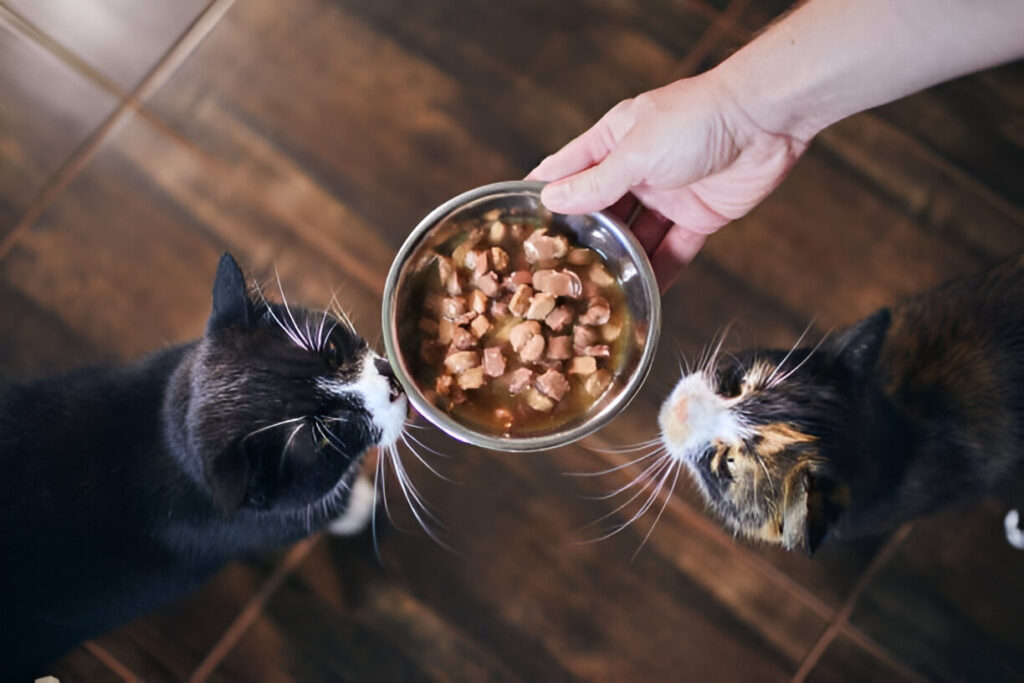
Understanding your cat’s caloric requirements is crucial for maintaining a healthy weight and ensuring their energy needs are met. The process involves calculating their Resting Energy Requirement (RER) and adjusting it based on their activity level. Here’s an in-depth guide:
1. Calculate Resting Energy Requirement (RER)
The Resting Energy Requirement is the number of calories a cat needs for basic functions like breathing, circulation, and maintaining body temperature while at rest. RER=70×(Body Weight in kg)0.75\text{RER} = 70 \times (\text{Body Weight in kg})^{0.75}
For example, if your cat weighs 4 kg: RER=70×(4)0.75≈70×2.828≈198 calories/day\text{RER} = 70 \times (4)^{0.75} \approx 70 \times 2.828 \approx 198 \, \text{calories/day}
2. Adjust for Activity Leve
After calculating the RER, multiply it by a factor that corresponds to your cat’s activity level:
- Indoor, Sedentary Cats: RER × 1.2
- These cats are less active and require fewer calories to avoid weight gain.
- Moderately Active Cats: RER × 1.4
- Cats that spend time playing, climbing, or exploring but are not highly active.
- Highly Active Cats: RER × 1.6
- Cats that engage in vigorous play, hunt regularly, or are outdoor explorers.
Using the 4 kg indoor cat example: Daily Caloric Needs=198 (RER)×1.2≈238 calories/day\text{Daily Caloric Needs} = 198 \, (\text{RER}) \times 1.2 \approx 238 \, \text{calories/day}
3. Consider Other Factors
- Life Stage:
- Kittens: Growing kittens require up to 2.5 times the RER during growth phases.
- Pregnant/Lactating Queens: Require significantly more calories, sometimes 2–4 times their RER, depending on the stage of pregnancy or lactation.
- Health Status:
- Cats with medical conditions (e.g., diabetes, hyperthyroidism) may need adjustments in caloric intake.
- Spayed or neutered cats may have slightly reduced energy needs.
4. Practical Application
When feeding your cat:
- Check Food Labels: Most commercial cat foods indicate the caloric content per serving (e.g., per cup, can, or pouch).
- Portion Control: Divide the total daily calorie requirement into two or more meals to maintain a healthy feeding routine.
- Monitor Weight and Adjust: Regularly assess your cat’s weight and body condition to ensure they are receiving the right amount of food.
Example Caloric Needs Based on Weight and Activity Level:
| Cat Weight (kg) | RER (calories/day) | Indoor (×1.2) | Moderately Active (×1.4) | Highly Active (×1.6) |
|---|---|---|---|---|
| 3 kg | 138 | 166 | 193 | 221 |
| 4 kg | 198 | 238 | 277 | 317 |
| 5 kg | 259 | 311 | 363 | 414 |
Regular monitoring of your cat’s weight and body condition is vital, as calorie needs can vary with changes in age, activity, and health. Consult your veterinarian if you’re unsure about your cat’s dietary requirements or if you’re making significant changes to their diet.
Dry Food vs Wet Food for Cats
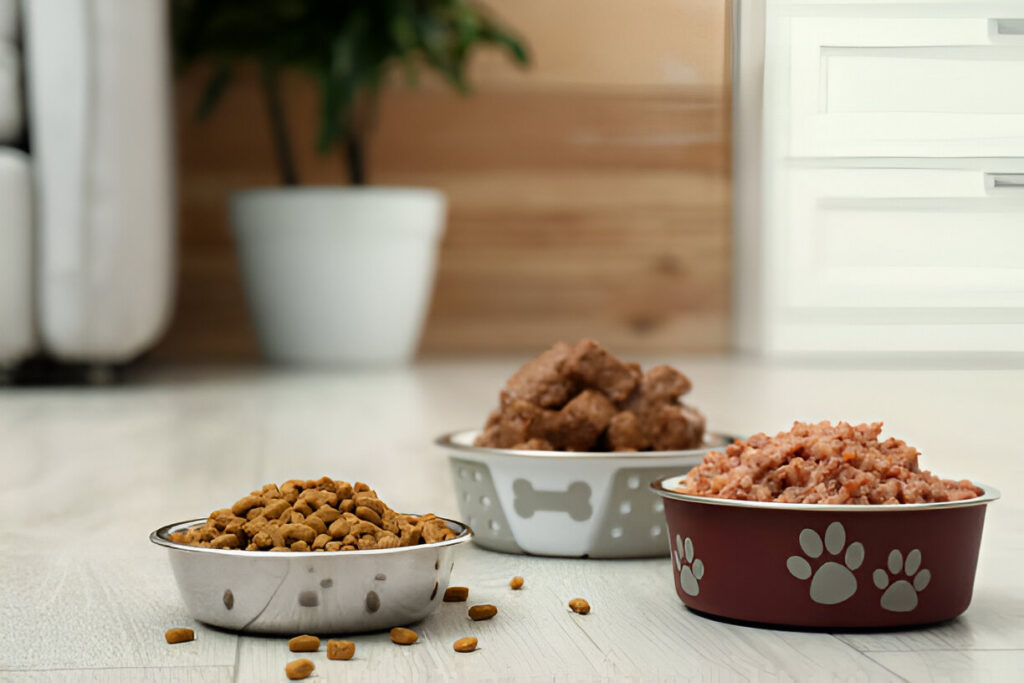
The bottom line on how to choose between dry food, wet food, or a combination of both is by making comparisons and weighing the pros and cons of each option for your specific cat’s needs, preferences, and health status. Here’s an expanded guide:
Dry Food
Pros:
- Convenience: Dry kibble is very easy to store, measure, and serve. It doesn’t need refrigeration and can stay out for many days without going bad, so it’s an ideal candidate for free-feeding.
- Affordability: It is usually less costly than wet food, making dry food a convenient choice for the owner of the pet.
- Dental Benefits-Limited: The crunchy texture can help in slight abrasive action which will help to remove tartar; however, it is no substitute for proper dental care.
Disadvantages:
- Low Moisture Content: Dry foods, with moisture content of about 6-10%, are incapable of delivering the necessary amount of water that cats require, let alone cats with chronic urinary and kidney disease. Cats tend to have low drive for thirst and, therefore, obtain a lot of their required water from their food.
- Risk of Overeating: Its high calorie density might cause over-consumption if not well portioned.
- Caloric Density:
- Dry food is very calorie-dense, with 300-500 calories per cup.
- It requires small portions, which can lead to easy overfeeding.
Wet Food
- Advantages:
- High Moisture Content: Wet food contains about 70-80% moisture, which helps in hydration and prevents urinary tract infections and kidney problems.
- More Similar to Natural Diet: The texture and composition of wet food often mimic the prey-like moisture levels found in a cat’s natural diet.
- High Palatability: Wet food is often more flavorful and appealing to cats, making it a great choice for picky eaters.
- Disadvantages
- Costly: Wet food tends to be more expensive per serving than dry food.
- Storage Requirements: Wet food, if opened, should be refrigerated and consumed within a day or two to avoid spoilage.
- Shorter Shelf Life: Once a can or pouch is opened, it must be used rather more quickly, which can be a drawback for some pet owners.
- Caloric Density:
- Wet food contains approximately 70-120 calories per 3-ounce can, depending on the brand and formulation.
- A larger amount needs to be given to satisfy calorific needs, thus feeding them more often.
Combination Feeding
Most cat owners feed a combination of dry and wet food so that both benefits are reaped. This will allow for:
- Variety in texture and flavor: Prevents boredom and promotes healthy eating habits.
- Improved Hydration: Feeding wet food makes your cat drink extra water.
- Nutritional Balance: Provides the best features of dry food as well as hydrating qualities from wet food.
What to Consider When Choosing Between Them
- Hydration Requirements: Those cats with the risk of developing urinary or kidney problems would have a higher preference for wet food since it has higher moisture content.
- Dental Health: Though dry food prevents tartar slightly, dental health requires regular maintenance; hence, wet food cannot be considered as an alternative here.
- Weight Management: In case of overweight cats, the lower calorie density in wet foods will give the feeling of fullness and keep their portions small.
- Budget and Convenience: Dry foods are cheaper and more convenient to store than wet foods, which require careful handling.
- Cat’s Preference: Some cats really like one more than the other, so keep in mind their taste and texture preferences.
Feeding Guidelines:
- Dry Food Only: Keep fresh water available at all times. Watch the amount fed to prevent overfeeding. End
- Wet Food Only: Feed multiple small meals a day to mimic a natural eating pattern.
- Combination: Use wet food for meals and leave dry food out for grazing, or mix them together to balance hydration and calorie density.
Ultimately, the best diet for your cat depends on their individual needs, health conditions, and lifestyle. Regular veterinary check-ups can help refine their feeding plan and ensure they receive optimal nutrition.
Portion Sizes and Feeding Frequency
Cats thrive on routine, so establishing consistent feeding times is important. Most adult cats benefit from being fed twice a day—once in the morning and once in the evening. However, some cats may prefer smaller, more frequent meals.
Portion sizes should be based on the feeding guidelines provided on the cat food packaging, adjusted to your cat’s specific caloric needs. For instance, if your cat requires 240 calories per day and their food contains 300 calories per cup, they should be fed approximately 4/5 of a cup daily.
Signs Your Cat Is Eating the Right Amount
Regular observation of your cat’s weight, body condition, and overall health can help you ensure their diet is meeting their nutritional needs. The following provides a detailed look at how to recognize the signs that your cat is eating the right amount of food:
1. A Stable, Healthy Weight
- Consistent Weight: A cat eating the right amount will maintain a stable, healthy weight over time.
- How to Check: Weigh your cat once a month on a pet or kitchen scale and record it.
- Ideal Weight Range: Ask your veterinarian for an ideal weight range for your cat based on breed, age, and size.
- Preventing Overweight or Underweight Conditions:
- Overweight cats are prone to diabetes or joint problems.
- Underweight cats may suffer from malnutrition, muscle loss, or underlying health conditions.
2. A Glossy, Well-Groomed Coat
- Shiny, Soft Fur: Proper nutrition, including adequate protein, fats, and vitamins, contributes to a glossy and smooth coat.
- Self-Grooming: Cats eating the right amount of high-quality food typically have the energy and overall health to groom themselves effectively.
- Dull, dry, or greasy coat; could suggest a nutritional imbalance, overfeeding, or an illness.
3. Normal activity and playful behaviors
- Maintains normal activity based on age and lifestyle if the cat is getting the right amount of food.
- Kittens and younger cats are more active and playful.
- Adult and Senior Cats: Overall, they are less active but still must have a venue for playing and exploring.
- Changes in Behaviour:
- Lethargy or low activity is usually indicative of underfeeding or lack of some nutrient.
- Hyperactivity especially with weight loss could be a result of overfeeding or an underlying medical problem like hyperthyroidism.
4. Regular, Well-Formed Stools
- Regular Bowel Movements: Properly fed cats have regular, firm, well-formed stools.
- Frequency: Normally, it’s once or twice a day, but again, this is subject to a slight variation due to diet.
- Odor and Appearance: Normal stools should not smell any more offensive than usual.
Changes in color, consistency, or frequency can indicate dietary imbalances or digestive issues.
Red Flags to Watch For
If you notice any of the following, it may mean a change in your cat’s diet or feeding pattern needs to be instituted:
Weight Changes:
- Gradual weight gain or loss might mean overfeeding or underfeeding.
Changes in Appetite:
- Sudden increase or decrease in appetite may indicate health problems, stress, or dissatisfaction with their food.
Coat Problems:
- Continuing dandruff, heavy shedding, or a dull coat may be symptoms of the need to change their diet.
Behavioral Changes:
- Increased irritability, hiding, or lethargy might be linked to nutritional deficiencies or excessive calorie intake.
Digestive Issues:
- Vomiting, diarrhea, or constipation are signs that your cat’s diet may not agree with them.
What to Do If You Notice Changes
- Your Veterinarian: Consult your veterinarian when there are dramatic changes in weight, appetite, behavior, or appearance. He or she can provide a physical examination, diagnostic testing, and suggestions on the feeding habits that should be implemented.
Reevaluate Feeding Habits. Review the portion sizes of food, the quality of food being fed, and your cat’s lifestyle to assure that their needs are being met.
Tips for Feeding Picky Eaters
Some cats are notoriously finicky about their food. To encourage them to eat:
- Warm the Food: Slightly warming wet food can enhance its aroma.
- Try Different Textures: Cats may prefer pate over chunks or vice versa.
- Mix It Up: Combine dry and wet food for variety.
- Create a Calm Feeding Environment: Minimize noise and distractions during mealtime.
- Transition Gradually: When switching foods, mix the new food with the old gradually over 7-10 days.
Special Considerations for Overweight Cats
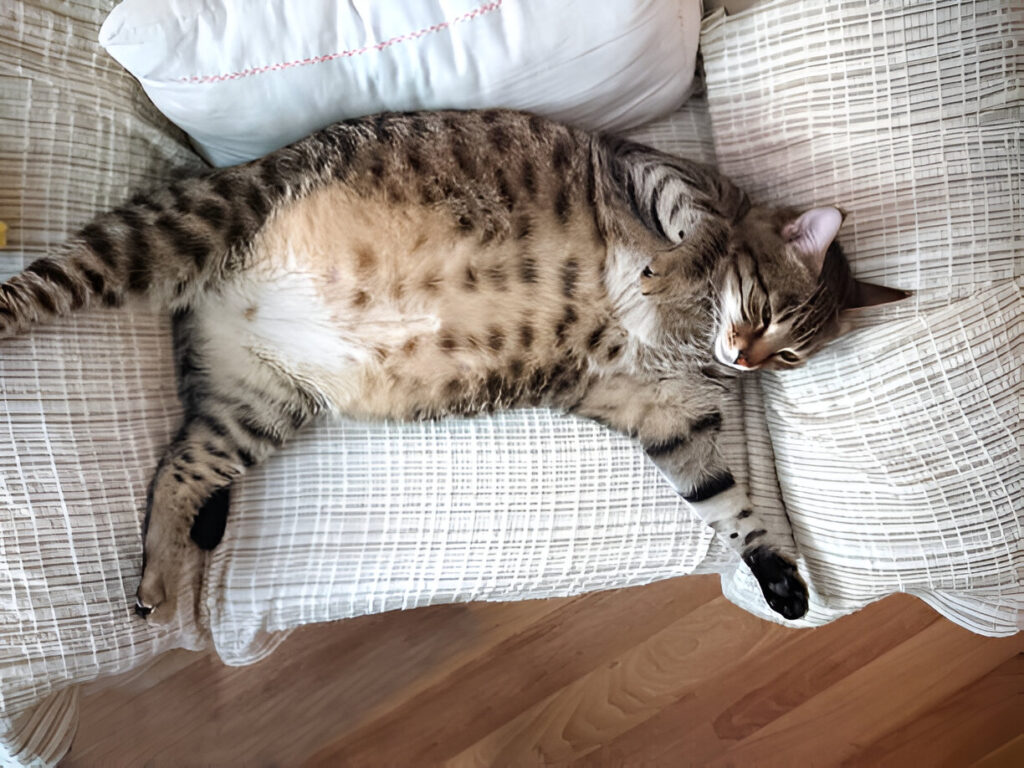
Obesity is a common issue in domestic cats, leading to various health problems such as diabetes, arthritis, and heart disease. To help an overweight cat shed pounds:
- Measure Portions: Avoid free-feeding and measure portions precisely.
- Choose Low-Calorie Foods: Opt for weight management formulas.
- Encourage Exercise: Use interactive toys or create climbing opportunities.
- Consult Your Vet: A veterinarian can recommend a tailored weight-loss plan.
Hydration and Its Importance
Cats naturally have a low thirst drive, relying on their diet for moisture. Wet food can significantly contribute to their hydration needs. For cats on a dry food diet, ensure fresh water is always available. Consider using a cat water fountain to encourage drinking.
When to Consult a Veterinarian About Your Cat’s Diet
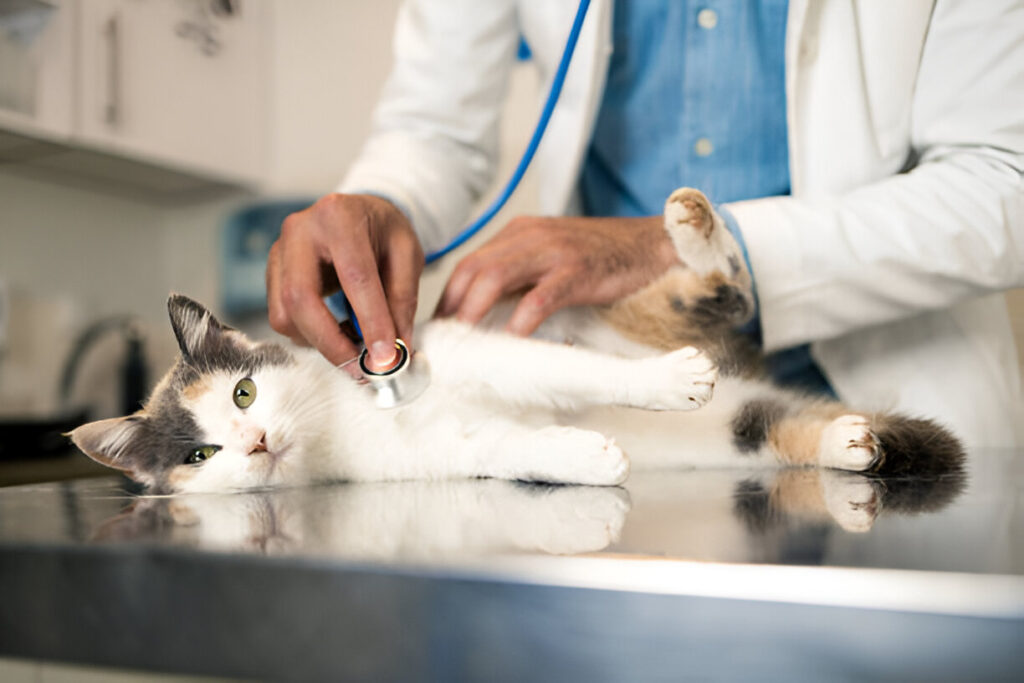
Your veterinarian is an invaluable resource for ensuring your cat receives the proper nutrition to support their health and well-being. Here’s an expanded guide on when and why to seek professional advice regarding your cat’s diet:
1. Assess Your Cat’s Health and Body Condition
- Routine Health Checks:
- During regular veterinary visits, your vet will evaluate your cat’s weight, body condition score (BCS), and overall health to ensure their diet meets their nutritional needs.
- They can identify if your cat is underweight, overweight, or at a healthy weight and recommend adjustments accordingly.
- Addressing Concerns:
- If you notice unexplained weight loss or gain, poor coat quality, lethargy, or behavioral changes, consult your vet. These could indicate an underlying issue related to diet or health.
2. Recommend Specific Food Brands or Formulations
- Tailored Diet Plans:
- Your vet can recommend high-quality commercial food brands or therapeutic diets tailored to your cat’s specific needs, such as age, activity level, or health conditions.
- For cats with allergies, sensitivities, or preferences, your vet can suggest alternative protein sources or hypoallergenic diets.
- Specialized Diets for Medical Conditions:
- Cats with conditions like diabetes, kidney disease, or obesity may require specialized veterinary diets. These formulations are designed to manage symptoms and improve quality of life.
- For example, cats with urinary tract issues may benefit from foods that promote hydration and maintain optimal urinary pH.
3. Provide Guidance on Feeding Amounts and Schedules
- Portion Control:
- Vets can calculate your cat’s daily caloric needs based on their weight, age, and activity level, ensuring they receive the correct portion size.
- Feeding Schedules:
- Your vet can help you establish a feeding routine, whether free-feeding, timed meals, or a combination approach.
- They can also advise on how to transition between food types (e.g., from kitten to adult food or wet to dry food).
4. Monitor Life Stage Transitions
- Kittens:
- Vets can guide you on transitioning your kitten from milk or kitten food to adult food at the appropriate age (around 12 months).
- Senior Cats:
- Older cats often require adjustments in their diet to accommodate changes in metabolism, dental health, or medical conditions.
5. Regular Check-ups Are Essential
- Catch Potential Issues Early:
- Routine veterinary visits help identify early signs of health issues, such as kidney disease or obesity, which can significantly benefit from dietary changes.
- Preventive Care:
- Annual or semi-annual check-ups allow your vet to monitor your cat’s nutritional status and recommend updates to their diet as needed.
When to Seek Immediate Veterinary Advice
Consult your vet promptly if your cat displays any of the following:
- Sudden Weight Changes: Unexplained weight gain or loss.
- Appetite Issues: Persistent refusal to eat or significant overeating.
- Digestive Problems: Frequent vomiting, diarrhea, or constipation.
- Behavioral Changes: Increased lethargy, irritability, or excessive grooming.
- Allergic Reactions: Symptoms like itching, hair loss, or skin irritation.
Questions to Ask Your Vet
When consulting your vet about your cat’s diet, consider asking:
- Is my cat’s current diet appropriate for their age, weight, and lifestyle?
- How much and how often should I feed my cat?
- Are there specific food brands or formulations you recommend?
- Should I consider supplements for my cat?
- How can I transition my cat to a new diet safely?
Conclusion
Determining how much an adult cat should eat requires considering various factors, including weight, activity level, and health status. By understanding your cat’s unique needs and monitoring their condition, you can provide a diet that promotes long-term health and happiness. Remember, every cat is different, so what works for one may not work for another. Always consult your veterinarian for personalized advice.
Your cat relies on you for their well-being, and feeding them appropriately is one of the most important ways to show your love and care. With the right approach, you can ensure your feline friend leads a healthy, fulfilling life.

